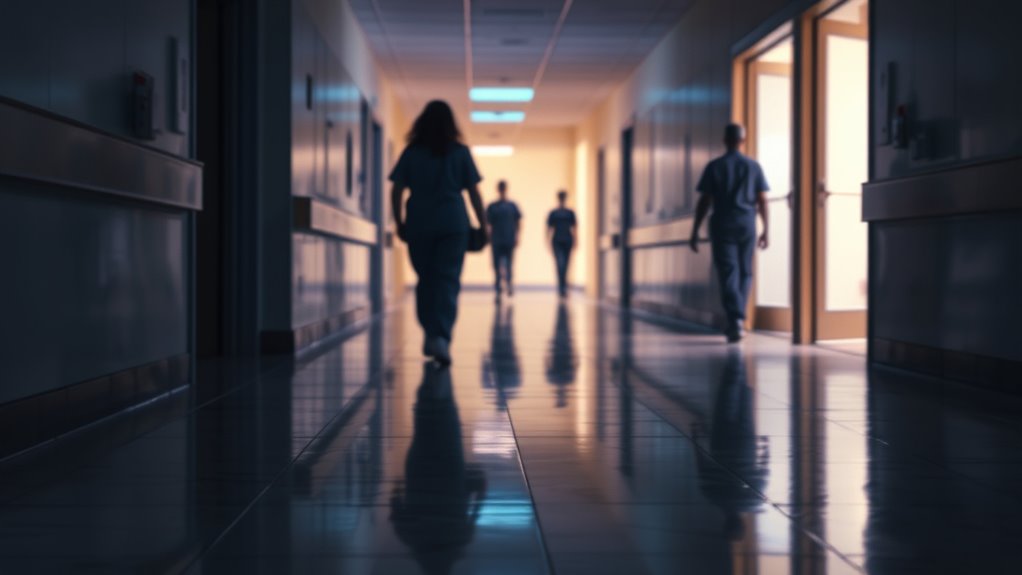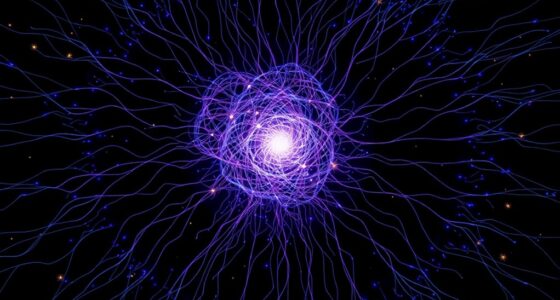The data on near-death experiences suggests they’re shaped by your brain’s responses to extreme stress, including changes in blood flow and neural activity. Your cultural and personal beliefs heavily influence the visions and sensations you might encounter, like lights or spirits. While some see NDEs as proof of an afterlife, scientists see them as natural brain functions. If you explore further, you’ll find much more about how these experiences blend biology, culture, and perception.
Key Takeaways
- Data shows NDEs are common across cultures, often involving vivid visions, peace, and encounters, regardless of religious beliefs.
- Physiological explanations, like brain activity changes during trauma, account for many NDE phenomena observed in studies.
- Cultural backgrounds influence NDE content, shaping visions, symbols, and interpretations reported by individuals.
- Statistical analyses suggest NDEs are more related to brain responses and psychological states than evidence of an afterlife.
- Ongoing research emphasizes the multifaceted nature of NDEs, integrating biological, psychological, and cultural factors in understanding the data.

Have you ever wondered what people see or feel when they come close to death? Near-death experiences, or NDEs, have fascinated humanity for centuries, sparking debates about their origins and meaning. Some believe they reveal glimpses of an afterlife, while others see them as psychological or physiological phenomena. When exploring these experiences, it’s essential to consider the role of scientific skepticism. Many scientists approach NDEs with caution, demanding rigorous evidence before accepting any supernatural explanation. They point out that brain activity changes dramatically during life-threatening situations, which can produce vivid hallucinations or sensations of peace and detachment. These physiological responses, such as reduced blood flow or altered neural function, might explain why some report seeing bright lights, feeling a sense of moving through a tunnel, or experiencing a review of their life. In this sphere, NDEs are seen as the brain’s way of coping with extreme stress, rather than proof of an afterlife. Moreover, the types of animals or beings reported in NDEs can sometimes reflect familiar dog breeds or other animals, influenced by cultural stories and personal experiences. Additionally, the brain’s neural circuitry may generate these complex visions, further supporting natural explanations. A growing body of research also suggests that cultural influences significantly shape the content and interpretation of these experiences, highlighting the importance of societal context. These influences extend to the perception of death, which varies greatly across different cultures and individual backgrounds. However, cultural influences play a significant role in shaping how these experiences are reported and interpreted. Different cultures have distinct ideas about death and the afterlife, which influence the content of NDEs. For example, Western accounts often mention encountering a bright light or feeling a sense of unconditional love, while some Eastern traditions describe meeting ancestors or spiritual guides. These cultural templates can shape the visions people report, suggesting that personal beliefs and societal norms heavily influence what individuals experience during near-death states. These observations highlight that personal and societal beliefs heavily impact the narratives around NDEs. This doesn’t necessarily mean these experiences are fabricated, but it highlights how deeply our cultural background colors our perceptions of death’s borderlands. When you consider the data, it becomes clear that NDEs are complex phenomena that combine physiological, psychological, and cultural components. While some interpret them as evidence of an afterlife, scientific skepticism urges us to explore natural explanations rooted in brain function. At the same time, cultural influences remind us that individual and societal beliefs shape the stories we tell about death’s edge. Whether you see NDEs as genuine glimpses into another realm or as extraordinary brain responses, they serve as a mirror reflecting our deepest fears, hopes, and cultural narratives about mortality. By understanding these factors, you gain a more nuanced view of what might be happening when someone comes close to crossing that final threshold.
Frequently Asked Questions
Are Near-Death Experiences the Same Across Different Cultures?
You might wonder if near-death experiences are the same across cultures. Generally, cultural interpretations shape how people perceive these events, influencing their spiritual symbolism. For example, some see a tunnel or a bright light, while others interpret these as encounters with ancestors or divine beings. Your cultural background can deeply influence the meaning you assign to these experiences, highlighting the diversity in how near-death experiences are understood worldwide.
Can Near-Death Experiences Be Scientifically Verified or Measured?
Imagine trying to catch a fleeting shadow—that’s how near-death experiences feel when you seek scientific proof. While some studies attempt quantitative measurement through brain scans or reports, the subjective nature makes experimental replication difficult. You can’t fully verify or measure NDEs like a physical phenomenon, but ongoing research aims to find consistent patterns, moving closer to understanding these mysterious experiences scientifically.
What Psychological Factors Influence the Content of Near-Death Experiences?
You might notice that psychological factors like emotional states and cognitive biases influence the content of near-death experiences. When you’re anxious or fearful, you may interpret visions differently than if you’re calm. Your biases, like cultural beliefs or personal expectations, shape what you perceive. These factors can color the experience, making it highly subjective. Understanding this helps explain why near-death experiences vary so much from person to person.
Do Medications or Medical Conditions Affect Near-Death Experiences?
You might think medications or medical conditions would prevent near-death experiences, but ironically, they often influence them. Medication effects can alter brain chemistry, leading to vivid visions or sensations, while certain medical conditions, like hypoxia, trigger experiences that feel real. So, instead of blocking these experiences, your health issues and meds could actually shape or intensify what you perceive during those critical moments.
How Do Near-Death Experiences Impact Long-Term Mental Health?
You might find that near-death experiences can boost your emotional resilience and promote post-traumatic growth. These profound moments often lead to a renewed sense of purpose, greater appreciation for life, and reduced fear of death. While some may experience lingering emotional challenges, many report long-term positive changes, helping them cope better with future stressors. Overall, these experiences can substantially influence your mental health in a beneficial way.
Conclusion
As you explore the data on near-death experiences, it’s like peering into a mysterious ocean where waves of stories and science collide. While no definitive answer surfaces, the evidence suggests these journeys might be more than just the mind’s final flicker. Keep an open mind, for like a lighthouse guiding ships through fog, the data hints at deeper truths waiting to be uncovered in this vast, uncharted territory of human consciousness.










